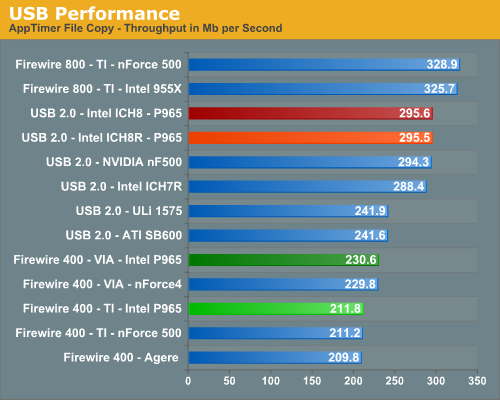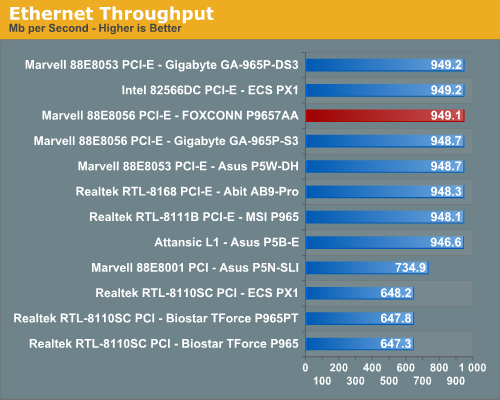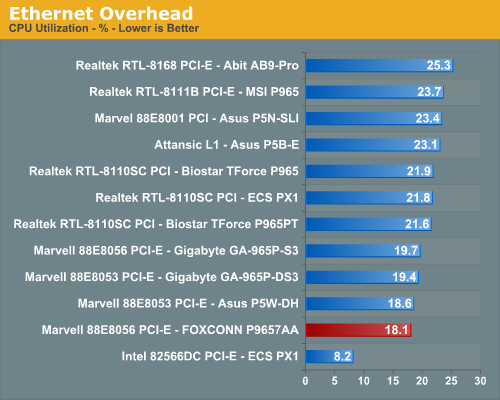Intel P965: Foxconn P9657AA- 8KS2H
by Gary Key on December 28, 2006 7:00 AM EST- Posted in
- Motherboards
Firewire and USB Performance
After looking at many options for Firewire and USB testing, we finally determined that an external USB 2.0, Firewire 400, and Firewire 800 hard disk would be a sensible way to look at USB and Firewire throughput. We utilize a RAM disk as our "server", since memory removes almost all overhead from the serving end. We turn off disk caching on the USB and Firewire side by setting up the drives for "quick disconnect" so our results are consistent.
We use 2GB of system memory with timings of 3-3-3-9 and set our RAM disk to 450MB with system memory at 1550MB. Our standard file is the SPECviewPerf install file, which measures 432,533,504 bytes (412.4961MB). After copying this file to our RAM disk, we measure the time for writing from the RAM disk to our external USB 2.0, Firewire 400, or Firewire 800 drive utilizing our internal Windows based timing program. The copy times in seconds are then converted into Megabits per second (Mb) to provide a convenient means of comparing throughput. Higher rates therefore mean better performance in this particular test.

The most interesting aspect in Firewire and USB throughput tests is the outstanding performance of an external hard drive connected to Firewire 800. Our benchmarks show Firewire 800 is up to 42% faster than a drive connected to the more common Firewire 400, and about 11% faster than the fastest USB 2.0 solution.
We see our Intel ICH8 chipset finally overtake perennial champion NVIDIA in USB 2.0 performance. The Firewire solution from VIA is still slightly faster than the TI solutions normally used on most motherboards.
Ethernet Performance
The current motherboard test suite includes LAN performance measurements. All of these boards utilize PCI or PCI Express based Gigabit controllers with the only difference being the supplier of the core logic.
The Windows 2000 Driver Development Kit (DDK) includes a useful LAN testing utility called NTttcp. We used the NTttcp tool to test Ethernet throughput and the CPU utilization of the various Ethernet Controllers used on the Intel motherboards.
We set up one machine as the server; in this test, an Intel system with an Intel CSA Gigabit LAN connection. Intel CSA has a reputation for providing fast throughput and is a logical choice for our Gigabit LAN server.
On the server side, we used the following Command Line as suggested by the VIA whitepaper on LAN testing:


The CPU utilization performance favors the Marvell Gigabit controllers with the Realtek solutions having the highest utilization numbers. However, the Intel solution on the ECS board has the lowest CPU utilization numbers we have seen in testing. The throughput numbers also favor the Marvell and Intel Gigabit controllers with the Realtek options close behind. The Foxconn board utilizes the Marvell 88E8056 solution used on the Gigabyte S3 board.
ASUS is now using the Attansic L1 PCI Express based controller chip and it posted comparable numbers to the more widely used Realtek and Marvell solutions. ASUS utilizes a PCI based Gigabit controller on the 570SLI even though the NVIDIA chipset has native support for Gigabit operations. This decision results in the worse throughput and average CPU utilization numbers. However, even with throughput at 646Mb/s it still exceeds what most home networks are capable of and certainly any DSL or Cable based Internet connection.
After looking at many options for Firewire and USB testing, we finally determined that an external USB 2.0, Firewire 400, and Firewire 800 hard disk would be a sensible way to look at USB and Firewire throughput. We utilize a RAM disk as our "server", since memory removes almost all overhead from the serving end. We turn off disk caching on the USB and Firewire side by setting up the drives for "quick disconnect" so our results are consistent.
We use 2GB of system memory with timings of 3-3-3-9 and set our RAM disk to 450MB with system memory at 1550MB. Our standard file is the SPECviewPerf install file, which measures 432,533,504 bytes (412.4961MB). After copying this file to our RAM disk, we measure the time for writing from the RAM disk to our external USB 2.0, Firewire 400, or Firewire 800 drive utilizing our internal Windows based timing program. The copy times in seconds are then converted into Megabits per second (Mb) to provide a convenient means of comparing throughput. Higher rates therefore mean better performance in this particular test.

The most interesting aspect in Firewire and USB throughput tests is the outstanding performance of an external hard drive connected to Firewire 800. Our benchmarks show Firewire 800 is up to 42% faster than a drive connected to the more common Firewire 400, and about 11% faster than the fastest USB 2.0 solution.
We see our Intel ICH8 chipset finally overtake perennial champion NVIDIA in USB 2.0 performance. The Firewire solution from VIA is still slightly faster than the TI solutions normally used on most motherboards.
Ethernet Performance
The current motherboard test suite includes LAN performance measurements. All of these boards utilize PCI or PCI Express based Gigabit controllers with the only difference being the supplier of the core logic.
The Windows 2000 Driver Development Kit (DDK) includes a useful LAN testing utility called NTttcp. We used the NTttcp tool to test Ethernet throughput and the CPU utilization of the various Ethernet Controllers used on the Intel motherboards.
We set up one machine as the server; in this test, an Intel system with an Intel CSA Gigabit LAN connection. Intel CSA has a reputation for providing fast throughput and is a logical choice for our Gigabit LAN server.
On the server side, we used the following Command Line as suggested by the VIA whitepaper on LAN testing:
Ntttcpr -m 4,0,‹server IP› -a 4 -l 256000 -n 30000
On the client side (the motherboard under test), we used the following Command Line:Ntttcps -m 4,0,‹client IP› -a 4 -l 256000 -n 30000
At the conclusion of the test, we captured the throughput and CPU utilization figures from the client screen.

The CPU utilization performance favors the Marvell Gigabit controllers with the Realtek solutions having the highest utilization numbers. However, the Intel solution on the ECS board has the lowest CPU utilization numbers we have seen in testing. The throughput numbers also favor the Marvell and Intel Gigabit controllers with the Realtek options close behind. The Foxconn board utilizes the Marvell 88E8056 solution used on the Gigabyte S3 board.
ASUS is now using the Attansic L1 PCI Express based controller chip and it posted comparable numbers to the more widely used Realtek and Marvell solutions. ASUS utilizes a PCI based Gigabit controller on the 570SLI even though the NVIDIA chipset has native support for Gigabit operations. This decision results in the worse throughput and average CPU utilization numbers. However, even with throughput at 646Mb/s it still exceeds what most home networks are capable of and certainly any DSL or Cable based Internet connection.










9 Comments
View All Comments
atlr - Friday, April 6, 2007 - link
A P9657AA-8EKRS2H / P9657AA-8KS2H BIOS dated April 5, 2007 has been released.No description about what's different though.
http://www.foxconnchannel.com/EN-US/service/downlo...">http://www.foxconnchannel.com/EN-US/ser...9657AA-8...
Sh0ckwave - Sunday, December 31, 2006 - link
343fsb is crap. no one will buy this for overclocking.ssiu - Thursday, January 11, 2007 - link
Seems like this could be a good option for ultra-budget E4300 overclocking. 9x343FSB = 3.087Ghz is pretty good. Save $30 on motherboard, use stock heatsink and save $$, save some more with cheaper DDR2-667 memory, etc.yyrkoon - Thursday, December 28, 2006 - link
Wouldnt it be nice is manufactures started making mother boards with loads of features, but without all the unnecessary stuff like SLI, dual GbE etc ?Personally, Id like to see a board like the Asus Striker, or ABIT IN9 32x-MAX, that didn't have SLI, and dual GbE. SO in other words, Something along the lines of these types of boards, but with the latest chip sets, eSATA (maybe), loads of disk ports, etc.
BladeVenom - Thursday, December 28, 2006 - link
I'd like to see at least one company make a motherboard with no legacy ports, and no built in audio. Who needs it, and why pay for it if you don't.Beachspree - Friday, December 29, 2006 - link
I'll keep repeating this with each review in the hope of getting a reply. ;-)I was wondering why the Firewire performance is so poor in these reviews:
Firewire 400 gets a best throughput of 230.6Mb/s
It is known that Macs have poor USB 2 performance but look at the Firewire results by Barefeats:
http://www.barefeats.com/usb2.html">http://www.barefeats.com/usb2.html
http://www.barefeats.com/hard70.html">http://www.barefeats.com/hard70.html
Without the perfect conditions of a RAM disk, and without cacheing turned off, they get real world performance of up to:
Firewire 400: 304 Mb/s (31% faster than PC)
Firewire 800: 464 Mb/s (41% faster than PC)
For comparison, Macs are getting lousy USB 2 performance. Intel Macs have improved it but that takes it from around 136Mb/s to 168Mb/s. That's 75% slower.
Given the importance of Firewire in multimedia applications, for which it can be critical, does this poor performance not warrant a mention?
To be clearer:
Can we please have some real world figures for USB 2.0, eSATA and Firewire 400/800 transfers under default settings and off an internal 7200 HDD you standardize on. That's what most people actually do when the backup, so that's what we need to see in order to make informed choices. I suspect these data rates you keep publishing are ones we will actually never see.
I suggest, also, that poor Firewire performance in Windows is more important than poor USB on Macs. They always have Firewire built in and tend to it on peripherals, while Windows users often make do with USB until they get into music or video editing when they then find the need for Firewire and hit this poor performance just when they start needing mission critical performance. I'm talking about dropped frames and music latency.
Why is that ignored in all your motherboard reviews?
Thanks.
SonicIce - Thursday, December 28, 2006 - link
What speakers or headphones do you use to test audio?Orbs - Thursday, December 28, 2006 - link
I have this board in a machine I'm using as a personal server. I paired it with G.Skill F2-6400CL5D-2GBNQ (2 x 1GB of DDR2 800) and it would crash randomly with that ram. After talking to G.Skill, it seems like there is an issue with that ram and all reference-based P965 boards including this board.Memtest86 also failed test #5 consistently with this ram on this board.
G.Skill is sending me replacement ram (their F2-6400PHU2-2GBNR) which should be here next week. Hopefully it's more stable.
Orbs - Thursday, December 28, 2006 - link
Just to be clear, I'm not saying this board or Foxconn is at fault for the compatibility issues, I'm just noting my experience so others don't run into the same problem.